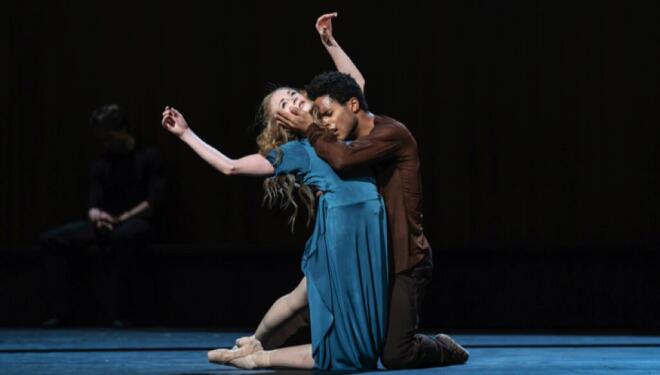'Just Trust the Steps!'
On the eve of the ROH world premiere of Secret Things, Culture Whisper discusses The Royal Ballet’s new commission with its choreographer Pam Tanowitz and composer Anna Clyne

As Tanowitz herself put it when we spoke: ‘If I’m doing things other people are already doing, that's not interesting.’

We met at the Royal Opera House just a couple of days before the world premiere at the Linbury of her third commission for The Royal Ballet, Secret Things. My question about the origin of the title brought out Tanowitz’s intuitive side.
‘It just felt right.’ After a brief pause, she elaborated: ‘I know the title is right, the way I know the steps should go in a certain spot. It’s a gut feeling, but there are some things throughout the piece that are recognisable balletic gestures that are like little secrets, little things I collected, and the dancers are very much part of finding those out.’
A piece for eight dancers, Secret Things is set to a string quartet by the New York-based British composer Anna Clyne, entitled Breathing Statues.

Clyne knows exactly where her title came from: German poet Raine Marie Rilke’s On Music.
Talking to Culture Whisper from her New York home, she quoted:
The silence of paintings. Language where language
ends. Time stands headed up
In the direction of hearts that wear out.’
Clyne’s string quartet was created for the 250th anniversary of Beethoven's birth in 2020, and she drew her inspiration from his Late Quartets and the Grosse Fuge.
‘One of the things that I like about Beethoven’s music is his use of silence, which he uses sparingly, but to great effect,' says Clyne. 'So there’s a moment in the Grosse Fuge where after all this turbulent energy the music grinds to a halt and we have this moment of silence followed by these two chords that feel incredibly poignant.
‘I wanted to capture that, particularly this idea of the string quartet being a breathing unit, the physical bodies, how they breathe together very often, which really relates to dance and the breath and movement.’
Much of what Clyne says evokes images of dance as created by Pam Tanowitz. In the same way as Clyne quotes from Beethoven, Tanowitz lightly and cleverly quotes from past dance traditions; so, she says, herself and Clyne are on ‘parallel planes.’
‘Things pop up. In Secret Things, some Balanchine hand flips, there’s a couple of Jerry [Jerome] Robbins things, but it is important for me to be able to frame it differently.
‘It’s not just about paying homage, which I love to do as well, but there is a deconstruction, a post-modern framework, and I think it comes from being not a ballet dancer.’
Pam Tanowitz’s style hits you as tremendously individual, always identifiably Tanowitz, even in works with their own distinctive characters such as the monumental Four Quartets, Everyone Keeps Me (her first Royal Ballet commission, which was part of the 2019 Merce Cunningham centenary) and last year’s Dispatch Duet also for The Royal Ballet.
Faces must be remain devoid of expression, because, she stresses, it’s all about the body. Trust the steps and it’s there.
‘A furrowed brow doesn’t help me in my work. I say to them, when you’re performing in my work you’re not performing up to the balcony. You’re here, you’re a person in this space; you don’t need to do that, you know, it’s extra.’
A very physical presence, Tanowitz gets up from her chair to demonstrate her point: ‘Just yesterday Giacomo [Rovero] was doing a slow grand plié and he did a little...’ One of her shoulders flutters slightly forward... 'And I said, No! Direct! Direct! Just do the thing.’
Not easy for ballet dancers, versatile as they may be, into whom the need for expressiveness has been drilled from an early age. So, very occasionally Pam Tanowitz compromises:
‘Sometimes I will allow a little ballet flourish, but it has to be specific.’
In the coming mixed bill Secret Things is paired off with the first reprise of Everyone Keeps Me. I asked whether there are resonances between the two pieces:
‘I think so, because I realised at the end of rehearsal yesterday, that Liam Boswell is exiting stage right and then in Everyone Keeps Me they enter the same way, and I thought, oh, that’s so interesting... do I want to change that? And then I thought, no, I think it makes the programme flow: he leaves and then they follow.
‘I feel like they are very different pieces. Another thing that was important to me when I was starting on Secret Things was that I wanted it to be on pointe, because the other piece is not. And that meant I had to choreograph it a different way.’
Both pieces are set to string quartets, but whereas the earlier piece responded to the dissonances of Ted Hearne’s score, Anna Clyne’s Breathing Statues is a softer, lush work:
‘The older I get, the more important melody becomes in my music. Melody has a very direct connection to movement, too, and I wonder if that’s something that Pam picked up in Breathing Statues.’
Sandwiched between the two there’s a short film of Dispatch Duet, directed by regular Royal Ballet collaborator Anthoula Syndica-Drummond, a film with which Pam Tanowitz pronounces herself satisfied, though, with a wistful smile, 'it could have been a bit longer.'
Judging by the previous Tanowitz works London has been lucky to see, Secret Things, too, is bound to create a flurry of excitement. And it'll be interesting to see how the two stage works play off each other.
In other words, I think Linbury audiences are in for a very special treat.
Secret Things/Everyone Keeps Me is at the Linbury Theatre, Saturday 4–Thursday 16 February. Details and tickets here.



